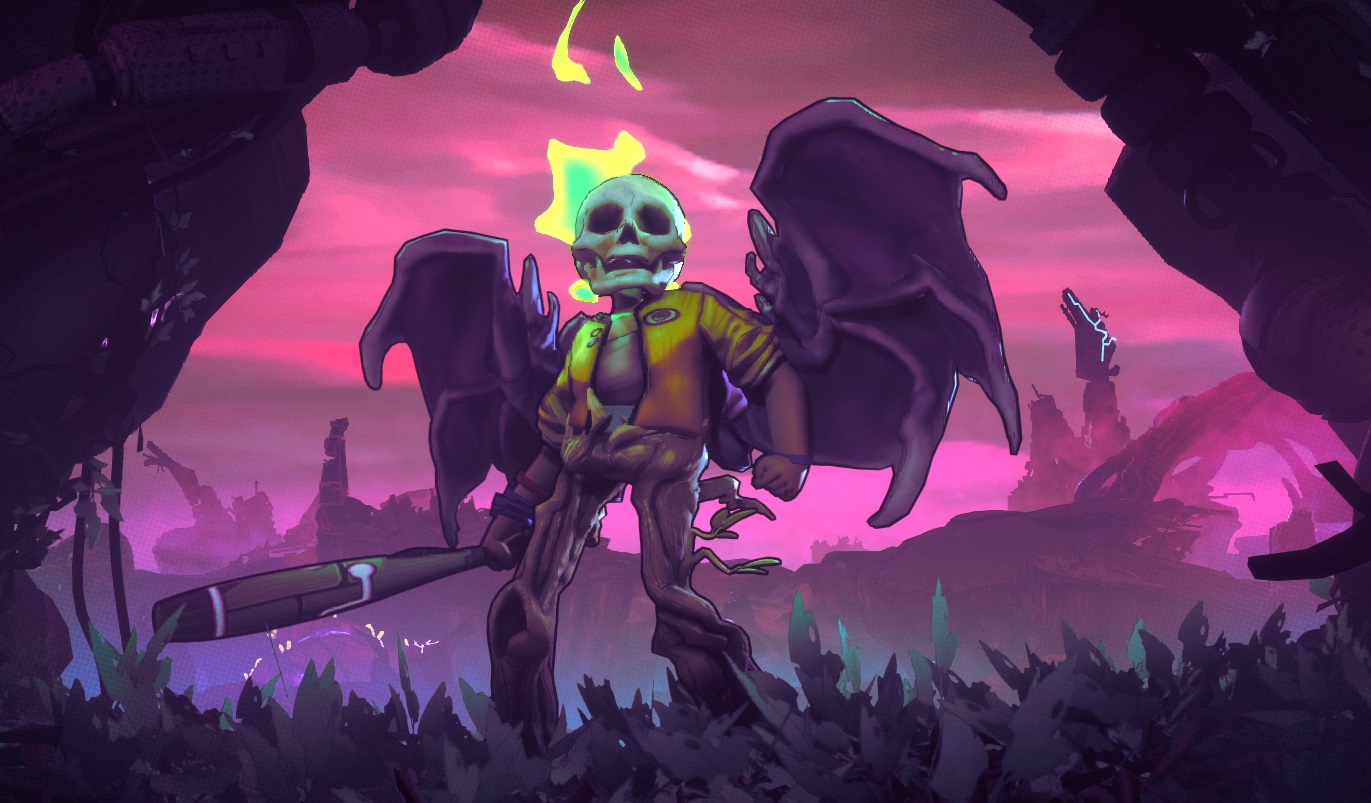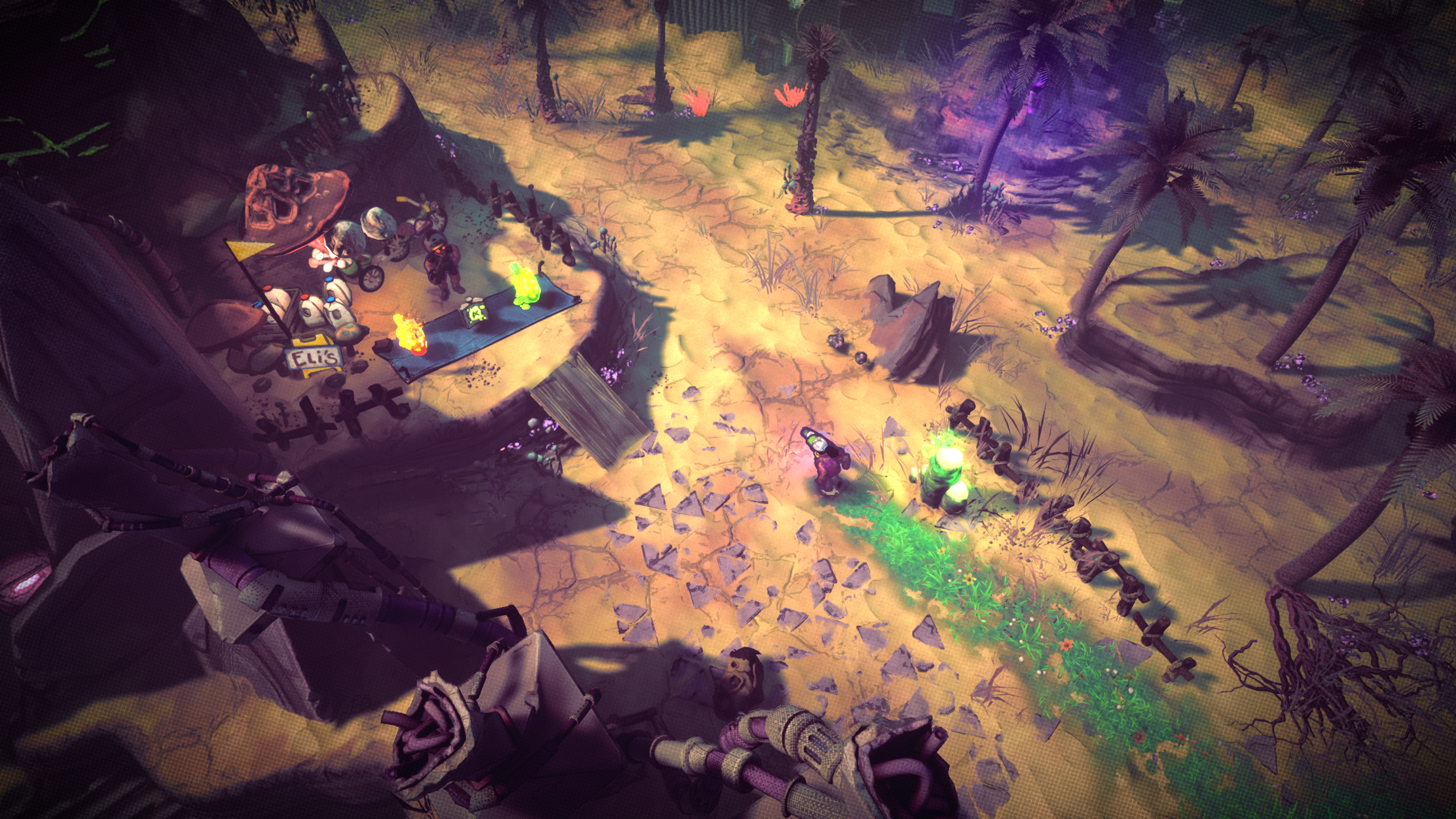Double Fine's making a roguelike brawler that's all about gross, funny mutations
Rad has a cheeky '80s post-post-apocalypse 'tude and you can grow a second brain out of your butt.

10 minutes into my first run in Rad, I grew a supersized brain that I could use to mind control an enemy. I took a quick breather from whacking post-post-nuke wasteland creatures with my baseball bat, used the right stick on the controller to take aim, twin-stick shooter style, and commandeered a monster to fight on my side. A few seconds later I accidentally bludgeoned it to death along with its former friends. I was still getting the hang of this whole being a mutant thing.
The best mutation I got turned me into Ghost Rider: the flesh melted off my skull, which then lit up with nuke-green flames. This was fine.
As I explored the dusty wasteland a stream of flowers blossomed in my wake, a convenient trail showing where I'd already been in the level. Those flowers also symbolize that I'm hella radioactive, which is the whole idea of Rad. The goal is to explore the wasteland, called the Fallow, and find a way to save the rest of humanity, but doing that involves turning into an irradiated mutant with, for example, a secondary butt brain that can slow down time or a flesh pouch for holding an extra item. The whole thing's wrapped up in a fun 80s aesthetic, with cassette tapes for cash and 5 ¼" floppies for chest keys.
"I was a teenager in the late 80s during the nuclear scare, and although I loved Mad Max, that was really not the sort of post-apocalypse game I wanted to make," Double Fine's Lee Petty told me. "I remember the sort of colorful, surreal worlds that got created back then, like the old school roleplaying game Gamma World, or some of the crazy movies that got made in Hollywood, where they were a lot more creative. It was like an alternate fantasy genre. I kind of wanted to make something in that vein, but I was looking for why we'd do a roguelike here at Double Fine."
Petty's answer, and the idea that ultimately shaped Rad into something familiar but a bit different from most roguelikes, is its world. It's predominantly outdoors instead of a series of rooms, and you leave your mark on the environment wherever you go. The flowers that bloom in your irradiated wake are designed to make backtracking easier (you run faster on your flower trail, and can even get mutations that make it bigger). You'll regularly run into flowers out in the Fallow that blossom wildly when you get close. It does feel like you're leaving your mark on the world as it leaves its mark on you, too. Instead of acquiring experience for killing enemies you accrue radiation, and a level up means a new mutation that's visible on your character.
The best mutation I got turned me into Ghost Rider: the flesh melted off my skull, which then lit up with nuke-green flames. This was fine. I could throw my skull at enemies and detonate it like a bomb. Another skull instantly grew to replace it.
"Early on we started thinking: Okay, we want to do mutations, and we want to see them on the character, not just as a really low-res item stack," Petty said. "We want to see this character change, and that started introducing themes of: It's kind of neat, and horrifying, that you are healing the world, it's slowly becoming a better place, while you're becoming less than human."
Mutations were also a clever solution for what Petty said he likes about roguelikes: Having to improvise with "imperfect tools."
The biggest gaming news, reviews and hardware deals
Keep up to date with the most important stories and the best deals, as picked by the PC Gamer team.

"A lot of times [roguelike mechanics] tend to be very fantasy roleplaying genre type stuff, like 'I don't know what this potion does.' I feel kind of disconnected from those mechanics, whereas here, when you get a mutation your whole character changes. You can see your character change, and it becomes part of their identity. You're not playing a barbarian or a wizard this time. To build mastery at this game, you have to play enough runs to have experienced enough of these different mutations to know how best to use them."
Your character in Rad is disposable, a colorfully dressed 80s teen with a bat who will probably die out there in the Fallow. Thematically, with every run you're helping heal the world, spreading new growth and new life with every flowery step. But the real meta structure is built around a town, which you can upgrade and change in ways that will carry over between runs. You'll unlock new items and artifacts by playing that add to the pool of drops you'll get in future runs. Combat is all about bats, and there are persistent unlockable ones that'll have different effects or attacks.
It's a fun world to play around with, and the mutations are a great spin on basic roguelike design. They can also branch and evolve as you level up. One mutation I saw slowed could zap an enemy to slow it down, but the upgraded form actually created a bubble of slowed time that affected everything in its radius. You'll encounter some mutations that come with drawbacks, much like the devil's power-ups in Binding of Isaac.
Without mutations, combat itself isn't as interesting—it's pretty basic top-down beat 'em up stuff, with very basic three-hit combos, a ground pound and a jump attack. The camera's zoomed out just far enough that you'll have to really look closely to make out the details of the environment or the enemies you're fighting. Combat didn't have the satisfaction for me of the roguelike genre's action standouts, like Nuclear Throne or Wizard of Legend, but its world has more going on than either of those games.
Rad is absolutely deeper than a beat 'em up, with branching mutations, ways you can interact with the environment (there's a surprising amount of elevation and stuff to find if you climb in the right places), and even small sidequests you can take on when you meet survivors out in the Fallow. But it does still evoke the feeling I get from years of playing other top-down brawlers or shooters where you fight through mobs of enemies: I wish it was a co-op game. The roguelike structure here is really nothing like Smash TV or Lara Croft and the Guardian of Light, but I loved playing those games with friends, and can't help thinking I'd rather clobber my way through this wasteland with some company.
Still, Double Fine's going out of its way to include the kinds of features modern roguelike players expect: daily challenges and meta unlocks that'll have you upgrading your town for many hours, across many runs, before you've seen and done it all. And to my knowledge, there's no other game out there that will spontaneously transform the top half of your body into a cobra, with the ability to snap your snake head out like a melee weapon. That's the Double Fine touch.
Rad's out this summer.

Wes has been covering games and hardware for more than 10 years, first at tech sites like The Wirecutter and Tested before joining the PC Gamer team in 2014. Wes plays a little bit of everything, but he'll always jump at the chance to cover emulation and Japanese games.
When he's not obsessively optimizing and re-optimizing a tangle of conveyor belts in Satisfactory (it's really becoming a problem), he's probably playing a 20-year-old Final Fantasy or some opaque ASCII roguelike. With a focus on writing and editing features, he seeks out personal stories and in-depth histories from the corners of PC gaming and its niche communities. 50% pizza by volume (deep dish, to be specific).

